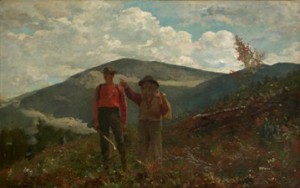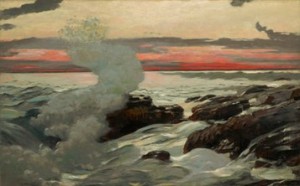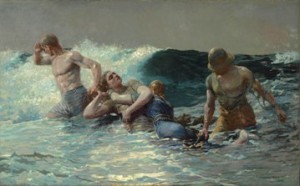by Seth Rogovoy

Winslow Homer (American, 1836–1910), Two Guides, 1877. Oil on canvas, 24 1/4 x 38 1/4 in. (61.6 x 97.2 cm). Sterling and Francine Clark Art Institute, Williamstown, Massachusetts, 1955.3
(WILLIAMSTOWN, Mass.) – Richard Rand, senior curator at the Sterling and Francine Clark Art Institute, says “We always say Renoir was the Clarks’ favorite artist, but it was really Homer.” And after viewing the summer’s blockbuster exhibition, Winslow Homer: Making Art, Making History, there will be no doubt in anyone’s mind if there ever was – Homer and the Clark will now and forever will be practically synonymous.
Selected works from what is reportedly the greatest collection of works by Winslow Homer (American, 1836–1910) assembled by one person since the artist’s death — and one of the leading collections of any art museum in the United States — are featured in Winslow Homer: Making Art, Making History, which explores the artist’s career from his beginnings as a commercial illustrator, through his great achievements in landscape and seascape paintings, to his works in other media, including prints, engravings, etchings and watercolors.
A surprising portrait of the artist emerges – one who had several careers all wrapped up into one. Homer got his start as a kind of proto-Norman Rockwell; the exhibition features a stunning ceiling-to-floor display of his magazine covers and illustrations (mostly from Harper’s Weekly). He made illustrations for books, newspapers – even sheet music covers. He worked in nearly every medium, experimenting with different printing techniques and even dabbled in photography. As much as he was driven to create great art, he always had one eye on the bottom line, “For him, art was business,” says the wall text, written by exhibition curator Marc Simpson.

Winslow Homer (American, 1836–1910), West Point, Prout’s Neck, 1900. Oil on canvas, 30 1/16 x 48 1/8 in. (76.4 x 122.2 cm). Sterling and Francine Clark Art Institute, Williamstown, Massachusetts, 1955.7
The centerpiece of the exhibit, at least to these eyes, but also suggested by the show’s layout, are four phenomenal seascapes that veritably light up from within, West Point and Summer Squall among them. They are given plenty of room to breathe and shimmer, halfway through a walk through the four-and-half-room show. They are stupidly brilliant, shockingly alive, pulsing with energy and dynamism. Consciously or not, they play with synesthesia; they anticipate psychedelia. A viewer could be forgiven for thinking he can hear the salt spray, feel the light crashing through the waves, or smell the sounds of the waves and sea birds.
Homer’s greatest landscapes, including Two Guides and Undertow, are invested with equal doses of formal brilliance and psychological tension – enough of the latter to make a viewer dizzy upon succumbing to Homer’s attempt to disarm you.
Some feel that Homer’s watercolors were the pinnacle of his creative process. The whimsical but powerfully abstract Fish and Butterflies (1900) could well anticipate surrealism.
 The exhibition is complemented by the first complete catalogue of the Clark’s Homer collection, Winslow Homer: The Clark Collection, authored by Simpson. The paintings in the Clark collection are recognized as being among Homer’s finest and offer insight into Homer’s thematic and technical development throughout his career. The presentation of Undertow (1886), along with six preparatory drawings accompanying it, gives an intimate look at the artist’s design process and offers insights into how Homer developed one of his most important figural works.
The exhibition is complemented by the first complete catalogue of the Clark’s Homer collection, Winslow Homer: The Clark Collection, authored by Simpson. The paintings in the Clark collection are recognized as being among Homer’s finest and offer insight into Homer’s thematic and technical development throughout his career. The presentation of Undertow (1886), along with six preparatory drawings accompanying it, gives an intimate look at the artist’s design process and offers insights into how Homer developed one of his most important figural works.
As much as it is a retrospective look at the depth and breadth of Winslow Homer’s art, the exhibition also tells the story of Sterling Clark’s decades-long pursuit of Homer’s works and his passion for creating what is now one of the most important collections of the artist’s work.
On view through September 8, 2013, Winslow Homer: Making Art, Making History showcases some sixty oil paintings, watercolors, drawings, and etchings, as well as approximately 120 rarely seen wood engravings. Drawing upon the resources of the Clark’s own holdings of nearly 250 works by Homer (dating from 1857 to 1904), the exhibition provides a variety of distinctive perspectives on this important American artist.
The exhibition is organized by the Sterling and Francine Clark Art Institute and is curated by Marc Simpson, associate director of the Williams College Graduate Program in the History of Art. Winslow Homer: The Clark Collection will be published by the Clark and distributed by Yale University Press in conjunction with the exhibition. More than thirty entries in the catalogue discuss the role of individual works in Homer’s oeuvre and their larger significance to the art world. An illustrated checklist provides information on titles, dates, and media for the entire collection.
